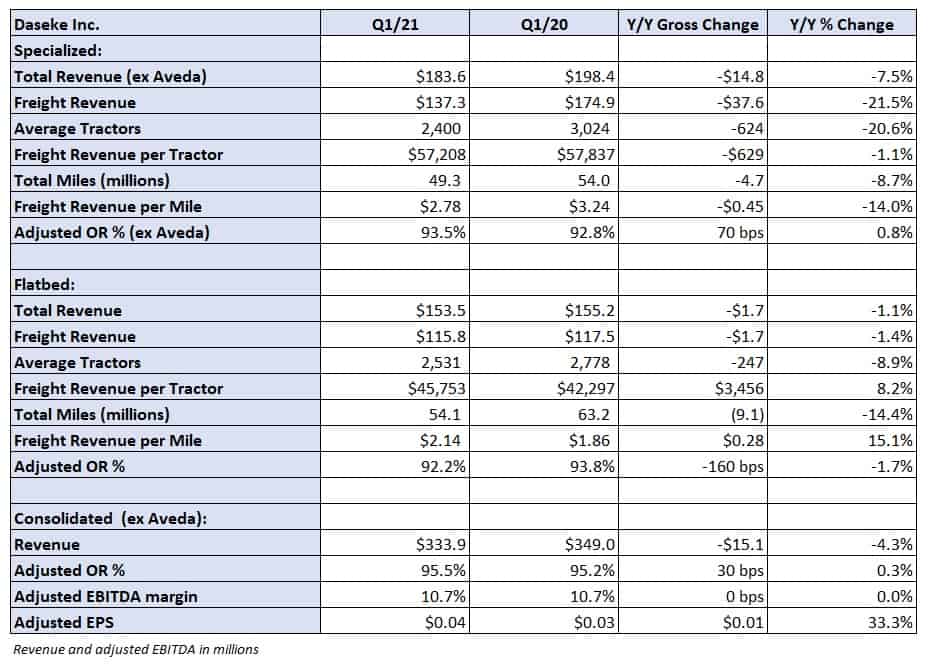The nation’s largest flatbed truckload provider, Daseke (NASDAQ: DSKE), reported first-quarter 2021 adjusted earnings per share of 4 cents Friday. The result was a penny better year-over-year and ahead of analysts’ expectations for a net loss of 5 cents per share.
The headline number, including results from Aveda, an oil rig transportation unit which the company has divested, was a net loss of 13 cents per share or $7.3 million.
Shares dip on report
Likely priced for perfection, shares of DSKE tanked on the open, falling 15% in early trading before recovering to down 9% by midday Friday. The S&P 500 was up 0.67% at the time.
Following a couple of quarters that highlighted a successful restructuring, the stock climbed 450% over the past year, and was up 34% year-to-date heading into the first-quarter report.
The turnaround has included consolidating its network of separately operated carriers from 16 to nine, divesting Aveda, disposing underutilized equipment, reducing headcount and building out its C-suite.
With the core business seeing a stronger flatbed environment, management didn’t raise its outlook for 2021, which was questioned on a call with analysts and investors.

The company reiterated its full-year guidance – revenue between $1.4 billion and $1.5 billion and adjusted earnings before interest, taxes, depreciation and amortization of $165 million to $175 million – versus guidance raises from other carriers.
However, the comparison to dry van carriers isn’t a fair comp as those fleets have been benefitting from red-hot consumer spending versus the industrial markets Daseke hauls for, which are still warming.
Another overhang on the stock may have been Daseke’s restatement of financials for prior periods. The Securities and Exchange Commission recently issued tighter guidance on the classification of stock warrants, now considered liabilities versus equity, for special purpose acquisition company mergers, prompting the adjustment.
Daseke became a public company through a SPAC merger in 2017.
The restatement didn’t change previously reported revenue, operating income, adjusted EBITDA, adjusted EPS or free cash flow.
First-quarter results
“We are pleased to report another solid quarter of financial and operational results, as the organization continues to demonstrate the value of our diverse portfolio of customers and end-markets served by our flatbed and specialized segments,” said Jonathan Shepko, interim CEO, in the press release.
Excluding Aveda, revenue was 4.3% lower year-over-year at $334 million. The decline in revenue was related to fewer load opportunities in the wind energy markets, which benefited from accelerated construction schedules last year ahead of renewable energy production tax credits that were set to expire. Those credits were extended through 2021, but a meaningful portion of the industry’s pipeline has already been pulled forward.

The company’s specialized delivery segment, which moves very large, heavy, project-type freight, saw revenue decline 7.5% year-over-year, excluding Aveda. An increase in shipments related to high-security cargo, construction and commercial glass partially offset declines in wind energy and aerospace demand.
Freight revenue per mile in the division declined 2% year-over-year, excluding Aveda, but revenue per tractor was up 4% as utilization improved.
Daseke’s general flatbed freight unit saw revenue dip slightly year-over-year. A 15.1% increase in freight revenue per mile led to an 8.2% increase in freight revenue per tractor. However, the improvement revenue per tractor had on segment revenue was offset as there were 247 fewer tractors in service on average.
Strength in construction markets moved steel and metals shipments up, which tightened capacity throughout the industry and sent rates higher.
The company’s consolidated adjusted operating ratio backed up 30 basis points year-over-year to 95.5%. Higher insurance and claims expense, fuel, and stock-based compensation were cited as the headwinds.
Also, purchased transportation expense, 510 bps higher as a percentage of freight revenue in the flatbed segment and up 200 bps on a consolidated basis, provided an obstacle. The flatbed segment used more owner-operators as a percentage of total power in the quarter. Owner-operators represented 62.9% of flatbed capacity compared to only 56.3% in the year-ago period.
Gains on asset sales were a tailwind, $1.9 million higher year-over-year. The improved line item benefited OR by 60 bps and added roughly 2 cents in adjusted earnings per share.
Daseke recently refinanced its term loan, lowering cash interest expense by $11 million annually. The company also increased its revolving asset-based facility by $50 million, increasing total capacity to $150 million.
Daseke generated $34 million in free cash flow during the quarter. Net debt declined more than $15 million from the end of 2020 to $488 million.
“We are encouraged by the broader-based demand uplift we are observing across many of the industrial verticals wherein we have established competitive advantages, and we will continue to leverage our differentiated scale and capabilities to serve our industrial market customers, while maximizing long-term value for our shareholders,” Shepko concluded.











